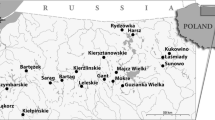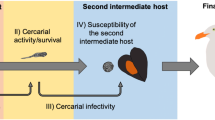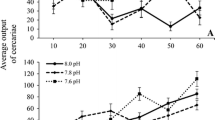Abstract
Blue mussels, Mytilus edulis, serve as second intermediate hosts for several trematode species, but little is known about the mechanisms underlying parasite infections in mussels. To reveal these mechanisms, the prevalence and intensity of trematode larvae (metacercariae in species of Gymnophallus, Himasthla and Renicola) were examined in blue mussels at 19 intertidal sites from the North Atlantic (Ireland, Iceland, Norway) to the Arctic Ocean (north-western Russia). Mussel samples were taken in 2005–2008. The impact of a number of environmental (maximal sea surface temperature, SSTmax) and biological factors (mussel age and density and the abundance of avian final hosts) on trematode infection was examined. Infection levels correlated with the interaction between local bird abundance and mussel age and density. They increased with mussel age but their dependence on mussel density and bird abundance varied among parasite genera. Prevalence and intensity increased with SSTmax for Renicola spp., but no relationship was found for Gymnophallus and Himasthla spp. The ambiguous effect of SSTmax is likely explained by the broad range of optimal temperatures for the normal functioning of trematode larvae (cercariae) infective for mussels and by the high dependence of the level of mussel infection on a combination of local ecological factors. High infection levels were observed even in localities with a low SSTmax. No mussels were infected in the most north-eastern population, probably due to extreme conditions in the Arctic intertidal preventing trematode transmission. Future warming of the Arctic may accelerate trematode transmission in this system.





Similar content being viewed by others
References
Anderson DR, Burnham KP, Thompson WL (2000) Null hypothesis testing: problems, prevalence, and an alternative. J Wildl Manag 64:912–923
Baker JM, Crothers JH (1986) Chapter 8. Intertidal rock. In: Baker JM, Wolff WJ (eds) Biological surveys of estuaries and coasts. Cambridge University Press, Cambridge, pp 157–197
Beliaeff B, O’Connor TP, Daskalakis DK, Smith PI (1997) US mussel watch data from 1986 to 1994: temporal trend detection at large spatial scales. Environ Sci Technol 31:1411–1415
Buckland ST, Burnham KP, Augustin NH (1997) Model selection: an integral part of inference. Biometrics 53:603–618
Burnham KP, Anderson DR (2002) Model selection and multimodel inference: a practical information–theoretic approach, 2nd edn. Springer Inc., New York
Buschbaum C, Dittmann S, Hong J-S, Hwang I-S, Strasser M, Thiel M, Valdivia N, Yoon S-P, Reise K (2009) Mytilid mussels: global habitat engineers in coastal sediments. Helgol Mar Res 63:47–58
Bustnes JO (1998) Size selection of blue mussels Mytilus edulis by common eiders Somateria mollissima in relation to shell content. Can J Zool 76:1787–1790
Bustnes JO, Galaktionov KV, Irwin SWB (2000) Potential threats to littoral biodiversity: Is increased parasitism a consequence of human activity? Oikos 90:189–190
Byers JE, Blakeslee AMH, Linder E, Cooper AB, Maguire TJ (2008) Controls of spatial variation in the prevalence of trematode parasites infecting a marine snail. Ecology 89:439–451
Combes C (2001) Parasitism, the ecology and evolution of intimate interactions. The University of Chicago Press, Chicago
Commito JA, Celano EA, Celico HJ, Como S, Johnson CP (2005) Mussels matter: postlarval dispersal dynamics altered by a spatially complex ecosystem engineer. J Exp Mar Biol Ecol 316:133–147
Curtis LA (2002) Ecology of larval trematodes in three marine gastropods. Parasitology 124:S43–S56
Dahl-Jensen D, Bamber J, Boggild CE, Buch E, Christensen JH, Dethloff K et al (2011) Chapter 8. The Greenland Ice Sheet in a changing climate. In: AMAP 2011. Snow, water, ice and permafrost in the Arctic (SWIPA): climate change and the cryosphere, AMAP, Oslo
de Montaudouin X, Lanceleur L (2011) Distribution of parasites in their second intermediate host, the cockle Cerastoderma edule: community heterogeneity and spatial scale. Mar Ecol Prog Ser 428:187–199
de Montaudouin X, Wegeberg AM, Jennsen KT, Sauriau PG (1998) Infection characteristics of Himasthla elongata cercaria in cockles as a function of water current. Dis Aquat Organ 34:63–70
de Montaudouin X, Binias C, Lassalle G (2012) Assessing parasite community structure in cockles Cerastoderma edule at various spatio-temporal scales. Estuar Coast Shelf Sci 110:54–60
Denisenko SG (2013) Biodiversity and bioresources of macrozoobenthos in the Barents Sea. Structure and long-term changes. Nauka, Saint Petersburg (in Russian)
Desclaux C, de Montaudouin X, Bachelet G (2004) Cockle Cerastoderma edule population mortality: role of the digenean parasite Himasthla quissetensis. Mar Ecol Prog Ser 279:141–150
Development Core Team R (2013) R: a language and environment for statistical computing. R Foundation for Statistical Computing, Vienna
Fredensborg BL, Mouritsen KN, Poulin R (2006) Relating bird host distribution and spatial heterogeneity in trematodes infection in an intertidal snail-from small to large scale. Mar Biol 149:275–283
Galaktionov KV (1993) Life cycles of trematodes as components of ecosystems. Kola Scientific Centre of the Russian Academy of Sciences Press, Apatity (in Russian)
Galaktionov KV (1996) Life cycles and distribution of seabird helminths in Arctic and sub-Arctic region. Bull Scand Soc Parasitol 6:31–49
Galaktionov KV, Bustnes JO (1999) Distribution patterns of marine birds digenean larvae in periwinkles along the southern coast of the Barents sea. Dis Aquat Organ 37:221–230
Galaktionov KV, Skírnisson K (2000) Digeneans from intertidal molluscs of SW Iceland. Syst Parasitol 47:87–101
Galaktionov KV, Kuklin VV, Ishkulov DG, Galkin AK, Marasaev SF, Marasaeva EF, Prokofiev VV (1997) On the helminths fauna of birds from the coast and islands of Eastern Murman (the Barents Sea). In: Matishov GG (ed) Ekologiya ptits i tyulenei v moryakh severo-zapada Rossii (Ecology of birds and seals in the seas of the Northwestern Russia). Kola Scientific Centre of the Russian Academy of Sciences Publ., Apatity, pp 67–153 (in Russian)
Galaktionov KV, Irwin SWB, Prokofiev VV, Saville DH, Nikolaev KE, Levakin IA (2006) Trematode transmission in coastal communities—temperature dependence and climate change perspectives. In: Hurd H (ed) Proceedings of the 11th international congress of parasitology. Medimond, Bologna, pp 85–90
Goater CP (1993) Population biology of Meiogymnophallus minutus (Trematoda: Gymnophallidae) in cockles from the Exe estuary. J Mar Biol Assoc UK 73:163–177
Granovitch AI, Sergievsky SO, Sokolova IM (2000) Spatial and temporal variation of trematode infestation in coexisting populations of intertidal gastropods Littorina saxatilis and L. obtusata in the White Sea. Dis Aquat Organ 41:53–64
Granovitch AI, Yagunova EB, Maximovich AN, Sokolova IM (2009) Elevated female fecundity as a possible compensatory mechanism in response to trematode infestation in populations of Littorina saxatilis (Olivi). Int J Parasitol 39:1011–1019
Grosholz ED (1994) The effects of host genotype and spatial distribution on trematode parasitism in a bivalve population. Ecology 48:1514–1524
Hechinger RF, Lafferty KD (2005) Host diversity begets parasite diversity: bird final hosts and trematodes in snail intermediate hosts. Proc R Soc Lond B Biol Sci 272:1059–1066
Hoberg EP, Kutz SJ, Cook J, Galaktionov KV, Haukisalmi V, Henttonen H, Laaksonen S, Makarikov A, Marcogliese DJ (2013) Chapter 15. Parasites. In: Meltofte H, Josefson AB, Payer D (eds) Arctic biodiversity assessment: status and trends in Arctic biodiversity. The conservation of arctic flora and fauna (CAFF), Arctic Council, Akureyri, pp 420–449. http://www.arcticbiodiversity.is/index.php/the-report/chapters/parasites
Jørgensen CB (1990) Bivalve filter feeding: hydrodynamics, bioenergetics, physiology and ecology. Olsen and Olsen, Fredensborg
Kattsov VM, Källén E (2005) Future climate change: modeling and scenarios for the Arctic. In: ACIA (ed) Arctic climate impact assessment. Cambridge University Press, New York, pp 99–150
Khaitov V (2013) Life in an unstable house: community dynamics in changing mussel beds. Hydrobiologia 706:139–158
Krasnov YuV, Goryaev YuI, Shavykin AA, Nikolaeva NG, Gavrilo MV, Chernook VI (2002) Atlas of the Pechora Sea birds: distribution, abundance, dynamics, problems of protection. Kola Branch of the Russian Academy of Sciences, Apatity (in Russian)
Krasnov YV, Gavrilo MV, Chernook VI (2004) Distribution of birds over the Pechora Sea: data of aerial surveys. Zool Zh 83:449–458 (in Russian)
Lauckner G (1983) Diseases of mollusca: Bivalvia. In: Kinne O (ed) Diseases of marine animals, vol 2. Biologische Anstalt Helgoland, Hamburg, pp 632–961
Lauckner G (1987) Ecological effect of larval trematode infestation on littoral marine invertebrate populations. Int J Parasitol 17:391–398
Levakin IA, Losev EA, Nikolaev KE, Galaktionov KV (2013a) In vitro encystment of Himasthla elongata cercariae (Digenea, Echinostomatidae) in the hemolymph of blue mussels Mytilus edulis as a tool for assessing cercarial infectivity and molluscan susceptibility. J Helminthol 87:180–188
Levakin IA, Nikolaev KE, Galaktionov KV (2013b) Long-term variation in trematode (Trematoda, Digenea) component communities associated with intertidal gastropods is linked to abundance of final hosts. Hydrobiologia 706:103–118
Loeng H, Blindhelm J, Andalsvlk B, Ottersen G (1992) Climatic variability in the Norwegian and Barents Seas. ICES Mar Sci Symp 195:52–61
Loos-Frank B (1967) Experimentelle Untersuchungen über Bau, Entwicklung und Systematik der Himasthlinae (Trematoda, Echinostomatidae) des Nordseeraumes. Z Parasitenk 28:299–351
Lynch SA, Morgan E, Carlsson J, Mackenzie C, Wooton EC, Rowley AF, Malham S, Culloty SC (2014) The health status of mussels, Mytilus spp., in Ireland and Wales with the molecular identification of a previously undescribed haplosporidian. J Invertebr Pathol. doi:10.1016/j.jip.2014.02.012
Marcogliese DJ (2005) Parasites of the superorganism: Are they indicators of ecosystem health? Int J Parasitol 35:705–716
Matthews PM, Montgomery WI, Hanna REB (1985) Infestation of littorinids by larval digenea around a small fishing port. Parasitology 90:277–287
Merlo MJ, Etchegoin JA (2011) Testing temporal stability of the larval digenean community in Heleobia conexa (Mollusca: Cochliopidae) and its possible use as an indicator of environmental fluctuations. Parasitology 138:249–256
Morley NJ, Lewis JW (2013) Thermodynamics of cercarial development and emergency in trematodes. Parasitology 140:1442–1452
Mouritsen KN, Poulin R (2002) Parasitism, community structure and biodiversity in intertidal ecosystems. Parasitology 124:S101–S117
Mouritsen KN, Poulin R (2010) Parasitism as a determinant of community structure on intertidal flats. Mar Biol 157:201–213
Mouritsen KN, McKechnie S, Meenken E, Toynbee JL, Poulin R (2003) Spatial heterogeneity in parasite loads in the New Zealand cockle: the importance of host condition and density. J Mar Biol Assoc UK 83:307–310
Nielsen TG, Maar M (2007) Effects of a blue mussel Mytilus edulis bed on vertical distribution and composition of the pelagic food web. Mar Ecol Prog Ser 339:185–198
Nikolaev KE, Sukhotin AA, Galaktionov KV (2006) Patterns in infection of the White Sea blue mussels (Mytilus edulis L.) of different age and size with metacercariae of digenetic trematodes Himasthla elongata (Mehlis, 1831) (Echinostomatidae) and Cercaria parvicaudata Stunkard and Shaw, 1931 (Renicolidae). Dis Aquat Organ 71:51–58
Overland JE, Wood KR, Wang M (2011) Warm Arctic—cold continents: climate impacts of the newly open Arctic Sea. Polar Res 30:15787. doi:10.3402/polar.v30i0.15787
Poulin R (2006a) Variation in infection parameters among populations within parasite species: intrinsic properties versus local factors. Int J Parasitol 36:877–885
Poulin R (2006b) Global warming and temperature-mediated increases in cercarial emergence in trematode parasites. Parasitology 132:143–151
Poulin R (2007) Evolutionary ecology of parasites. Princeton University Press, Princeton
Prinz K, Kelly TC, O’Riordan RM, Culloty SC (2011) Factors influencing cercarial emergence and settlement in the digenean trematode Parorchis acanthus (Philophthalmidae). J Mar Biol Assoc UK 91:1673–1679
Prokofiev VV (2001) Reactions to the light of the littoral trematode Renicola thaidus (Trematoda: Renicolidae). Parazitologiya 35:429–435 (in Russian)
Prokofiev VV (2002) Vertical migration of cercariae of the littoral trematode Renicola thaidus (Trematoda: Renicolidae) in the water layer. Parazitologiya 36:316–323 (in Russian)
Prokofiev VV (2006) Strategies of the animal hosts infection with trematode cercariae: an attempt of analysis in marine coastal and lake ecosystems of northwestern Russia. Dissertation, Zoological Institute of the Russian Academy of Sciences, St. Petersburg (in Russian)
Prokofiev VV, Galaktionov KV (2009) Strategies of search behaviour in trematode cercariae. Proceedings of the Zoological Institute 313:308–318 (in Russian)
Skírnisson K, Galaktionov KV, Kozminsky EV (2004) Factors influencing the distribution of digenetic trematode infections in a mudsnail (Hydrobia ventrosa) population inhabiting salt marsh ponds in Iceland. J Parasitol 90:50–59
Smaal AC (2002) European mussel cultivation along the Atlantic coast: production status, problems and perspectives. Hydrobiologia 484:89–98
Smith NF (2001) Spatial heterogeneity in recruitment of larval trematodes to snail intermediate hosts. Oecologia 127:115–122
Studer A, Widmann M, Poulin R, Krkošek M (2013) Large scale patterns of trematode parasitism in a bivalve host: no evidence for latitudinal gradient in infection levels. Mar Ecol Prog Ser 491:125–135
Stunkard HW (1964) Studies on the trematode genus Renicola: observations on the life history, specificity and systematic position. Biol Bull 126:468–489
Stunkard HW, Shaw CR (1931) The effect of dilution of sea water on the activity and longevity of certain marine cercariae, with description of two new species. Biol Bull 61:242–271
Sukhotin A, Berger V (2013) Long-term monitoring studies as a powerful tool in marine ecosystem research. Hydrobiologia 706:1–9
Sukhotin AA, Krasnov YV, Galaktionov KV (2008) Subtidal populations of the blue mussel Mytilus edulis as key determinants of waterfowl flocks in the southeastern Barents Sea. Polar Biol 31:1357–1363
Theisen BF (1973) The growth of Mytilus edulis L. (Bivalvia) from Disko and Thule district. Greenland. Ophelia 12:59–77
Thieltges DW (2006) Effect of infection by the metacercarial trematoda Renicola roscovita on growth in intertidal blue mussel Mytilus edulis. Mar Ecol Prog Ser 319:129–134
Thieltges DW (2007) Habitat and transmission—effect of tidal level and upstream host density on metacercarial load in an intertidal bivalve. Parasitology 134:599–605
Thieltges DW, Reise K (2007) Spatial heterogeneity in parasite infections at different spatial scales in an intertidal bivalve. Oecologia 150:569–581
Thieltges DW, Rick J (2006) Effect of temperature on emergence, survival and infectivity of cercariae of the marine trematode Renicola roscovita (Digenea: Renicolidae). Dis Aquat Organ 73:63–68
Thieltges DW, Jensen KT, Poulin R (2008) The role of biotic factors in the transmission of free-living endohelminth stages. Parasitology 135:407–426
Thieltges DW, Fredensborg BL, Poulin R (2009) Geographical variation in metacercarial levels in marine invertebrate hosts: parasite species character versus local factors. Mar Biol 156:983–990
Thieltges DW, Marcogliese DJ, Blanar CA, Poulin R (2013) Trematode prevalence–occupancy relationships on regional and continental spatial scales in marine gastropod hosts. Mar Ecol Prog Ser 490:147–154
Thomas F, Guégan J-F, Renaud F (eds) (2009) Ecology and evolution of parasitism. Oxford University Press, New York
Väinölä R, Strelkov P (2011) Mytilus trossulus in Northern Europe. Mar Biol 158:817–833
Viarengo A, Lowe D, Bolognesi C, Fabbri E, Koehler A (2007) The use of biomarkers in biomonitoring: a 2-tier approach assessing the level of pollutant-induced stress syndrome in sentinel organisms. Comp Biochem Phys C 146:281–300
Werding B (1969) Morphologie, entwicklung und ökologie digener trematoden–larven der strandschpecke Littorina littorea. Mar Biol 3:306–333
Wilson JG, Galaktionov KV, Sukhotin AA, Skírnisson K, Nikolaev KE, Ivanov MV, Bustnes JO, Saville DH, Regel KV (2013) Factors influencing trematode parasite burdens in mussels (Mytilus spp.) from the North Atlantic Ocean across to the North Pacific. Estuar Coast Shelf Sci 132:87–93
Wood SN (2006) Generalized additive models: an introduction with R. Chapman and Hall/CRC, Boca Ranton, London, New York
Wood SN (2014) The mgcv package: GAMs with GCV smoothness estimation and GAMMs by REML/PQL. R package version 1.8-3
Zbawicka M, Drywa A, Śmietanka B, Wenne R (2012) Identification and validation of novel SNP markers in European populations of marine Mytilus mussels. Mar Biol 159:1347–1362
Zolotarev VN (1989) Sclerochronology of marine bivalve mollusks. Naukova Dumka, Kiev (In Russian)
Zuur AF, Ieno EN, Walker NJ, Saveliev AA, Smith GM (2009) Mixed effects models and extensions in ecology with R. Springer, New York
Acknowledgments
This study was supported by grants from INTAS (Ref. No. 05–1000008–8056), the Russian Foundation for Basic Research (No. 13–04–00875) and St. Petersburg State University (No. 1.37.80.2011).
Author information
Authors and Affiliations
Corresponding author
Additional information
Communicated by J. Grassle.
Electronic supplementary material
Below is the link to the electronic supplementary material.
Rights and permissions
About this article
Cite this article
Galaktionov, K.V., Bustnes, J.O., Bårdsen, BJ. et al. Factors influencing the distribution of trematode larvae in blue mussels Mytilus edulis in the North Atlantic and Arctic Oceans. Mar Biol 162, 193–206 (2015). https://doi.org/10.1007/s00227-014-2586-4
Received:
Accepted:
Published:
Issue Date:
DOI: https://doi.org/10.1007/s00227-014-2586-4




